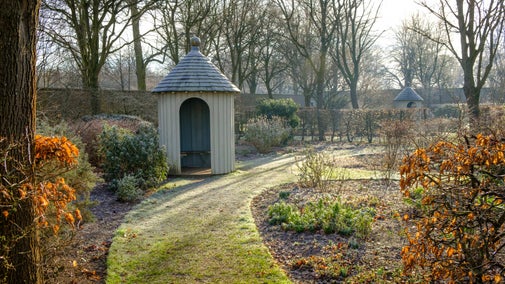
Discover more at Ham House and Garden
Find out when Ham House and Garden is open, how to get here, the things to see and do and more.

The garden at Ham House is rooted in centuries of history but the effects of climate change mean that it now faces its biggest challenge. Find out how we’re adapting to changing weather patterns, reducing carbon emissions and addressing the damage that's already been done.
The effects of climate change are having a serious impact at Ham House. Extreme weather, unpredictable rainfall, drought and flooding are all taking their toll on landscapes and buildings. There is now a 10-25% chance of a heatwave each year, compared to a less than 10% chance a decade ago.
Ham House's position on the banks of the Thames makes it vulnerable to flooding as heavy rainfall causes the river to overflow. It’s not just rain that causes issues. Drier weather during spring is affecting blossom, fruit and young plants and has also seen an increase in pests and diseases. Soaring temperatures are drying out the soil and scorching plants that once thrived in the walled garden.

The changes we’re making to Ham House's garden is the biggest intervention we’ve made since 1975. The extremes of temperature we're experiencing mean that it is facing some danger, but it’s also an opportunity to rethink and consider ways of running the garden more sustainably.
Visitors to Ham House are part of the changes too. To ensure visitors can enjoy the garden during particularly high temperatures, the benches are moveable so we can change the positions around the garden and so some are always in the shade.
We’ve seen much more frequent flooding at Ham House over the last five years and as a result, the trees that we plant need more care and management. Extra care is also vital during periods of spring drought and intense summer heat.
We’ve planted a lot of apple trees in the garden because they can thrive in a variety of climates. Our mix of apples include local and modern varieties. The diverse mix has a strong resistance to certain diseases.
The rapid increase in heat and humidity could result in 40C days becoming common by 2040, so our garden team take a climate-aware approach.
This means altering the types of plants introduced to include those more resilient to high temperatures, such as cannas and agaves. A Mediterranean diet of outdoor-grown aubergines, chillies and a long tomato season could become the norm.

Water usage is an important consideration in the National Trust’s climate change plans, and it also has a crucial role in the large gardens that we care for. Ham House only uses water harvested on site with a Victorian irrigation system. Rainfall from the house guttering is collected in water chambers that irrigate through the rest of the garden. Collectively, these changes will protect Ham House against climate change for future generations.
Over the years staff and volunteers have lovingly tended the garden and they are working hard to tackle the effects of climate change. A number of measures, such as planting more resilient species of trees and plants, have been taken to protect Ham House and garden for future generations.

Find out when Ham House and Garden is open, how to get here, the things to see and do and more.

Explore the well-preserved interiors of one of the grandest Stuart houses in England, created to impress in the 17th-century by the Duchess of Lauderdale and her husband the Duke.

Winter is an ideal time to take a stroll and enjoy the structure of the gardens around Ham House. Wander around the architectural Cherry Garden and explore the hedge-lined compartments of the Wilderness. Discover more seasonal highlights.

Take a look behind the scenes and discover the work that goes into keeping this special place looking its best.

Thinking about volunteering at this special place? Here’s what you need to know.

Wander around the riverside landscape surrounding Ham House and explore parkland, meadows and wetland.

Together, we're securing our future with action on climate and the environment. Learn more about how we're responding to the changing climate at places in our care.